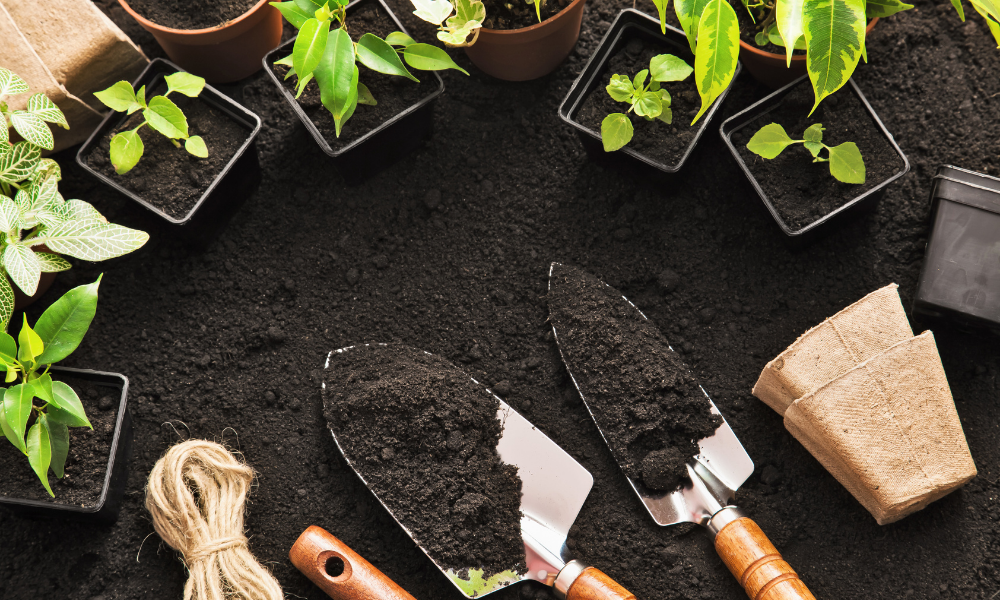Spring has sprung — our farm is covered in bright daffodils and blooming redbuds! Watching the farm come to life after the cold of winter is always my favorite. Our Stoney Creek is full to the brim from all the recent rain (we’ve had a record-high 7.5 inches over just a few days), and the rushing water is so relaxing to listen to when I cross the bridge over it to feed the goats.
Despite the springtime blooms, a hard freeze is supposed to hit tonight. Hopefully it’s our last, though! Middle Tennessee usually has its last frost date by mid-April, so we’re gearing up for transplanting our greenhouse seedlings in-ground soon after the frost date has passed.
If you’re a beginner gardener this year, it can be easy to get overwhelmed by all the tool options in the gardening section at your local feed and seed.
So I’ve made it easy for you. Below are the 4 best gardening tools every gardener needs in their arsenal.
If you are new to gardening, make sure to add these 4 gardening tools to your shopping list!
1. Garden Hoe
A hoe is one of the original tools humans used for agriculture, going back as far as ancient Egypt. It is your most basic—and necessary!—tool that will help you to keep soil aerated while also dislodging pesky weeds.
There are a few varieties of garden hoes. I recommend beginner gardeners to start with a paddle hoe and a stirrup hoe. You can expand to the other speciality garden hoes as needed.
Paddle / Draw Hoe
This is your run-of-the-mill gardening hoe and a good place to start if you are new to gardening. The blade at the end is angled at 90-degrees, making it ideal for uprooting weeds and working with soil. You can find different paddle sizes for spaces that are harder to reach.
Stirrup Hoe
The stirrup hoe looks like its namesake—the stirrup-like attachment on the end allows you to uproot weeds in a back-and-forth motion, as opposed to the chopping / digging motions used with the paddle hoe.
Collinear or Onion Hoe
This tool is meant for weeding in small spaces, as evidenced by its thin blade.
Warren or Dutch Hoe
The Warren / Dutch hoe is great for digging trenches or planting bulbs. The blade at the end is shaped like a triangle, also making it easy to get into narrow spaces.
2. Trowel
A trowel is a small handheld “shovel” used for digging, transferring plants into in-ground gardens, repotting plants, weeding… you name it, a trowel will be one of your most-used garden tools.
3. Cool Gloves
A good pair of gardening gloves is a nonnegotiable gardening tool. Gardening gloves are like your hands’ guardian angels, protecting your skin from chemical irritants, harmful UV rays, and sharp-edged tools.
Although you will need a good pair of leather work gloves for “hard” jobs, a cool glove option made out of bamboo will keep your hands both protected and cool. Plus, bamboo is a great all year round material. There are also less expensive options out there with a stretchy jersey material on the top.
4. Watering Can
Even if you have a watering hose, a watering can will help you reach the spaces in your garden that your hose can’t. Additionally, the higher water pressure of a hose can be harsh on seedlings and new plant transplants. This is when a watering can plays the role of hydration hero for your plant babies.
If you have quite a bit of garden square footage, you’ll want a watering can with higher water volume capacity. Most cans typically hold between 1 – 2.5 gallons of water. Look for a watering can with a cap that has small holes so the water is disbursed as droplets rather than one heavy stream.
However if you have hanging plants, a long-spouted watering will help you reach these.
Plastic cans will last longer (no rusting!) and are more lightweight than metal cans—something to consider when you are lugging around 2.5 gallons of water!
This watering can from Gardener’s Supply is a great option, but you can find others that are similar and lower in price if this one doesn’t fit your budget.
For watering and misting sunroom or indoor plants, consider this Sprayman Green Watering Can, which conveniently waters and sprays plants in one handy unit.
BONUS TIP: How to Clean Your Garden Tools
Plants can pass soil-borne diseases to one another through lingering dirt and pathogens clinging to your gardening tools, so it’s important to establish a regular routine of cleaning and disinfecting your tools throughout the growing season.
Clean your tools with a wire brush or steel wool to remove any residual dirt. For easier cleaning, disassemble tools that have multiple parts to them—that way you can get in every crook and cranny.
After a good wire scrubbing, a dip in disinfectant is in order. A 30 minute soak in a cleaning cocktail of 10% bleach to 90% water should do the job. Rinse with clean water afterward.
I recommend thoroughly cleaning all gardening tools at least once a month throughout the growing season. By disinfecting the tools that touch the individual plants, you will prevent diseases from spreading. If that feels too time consuming, then at the very least rinse your tools off between use.


